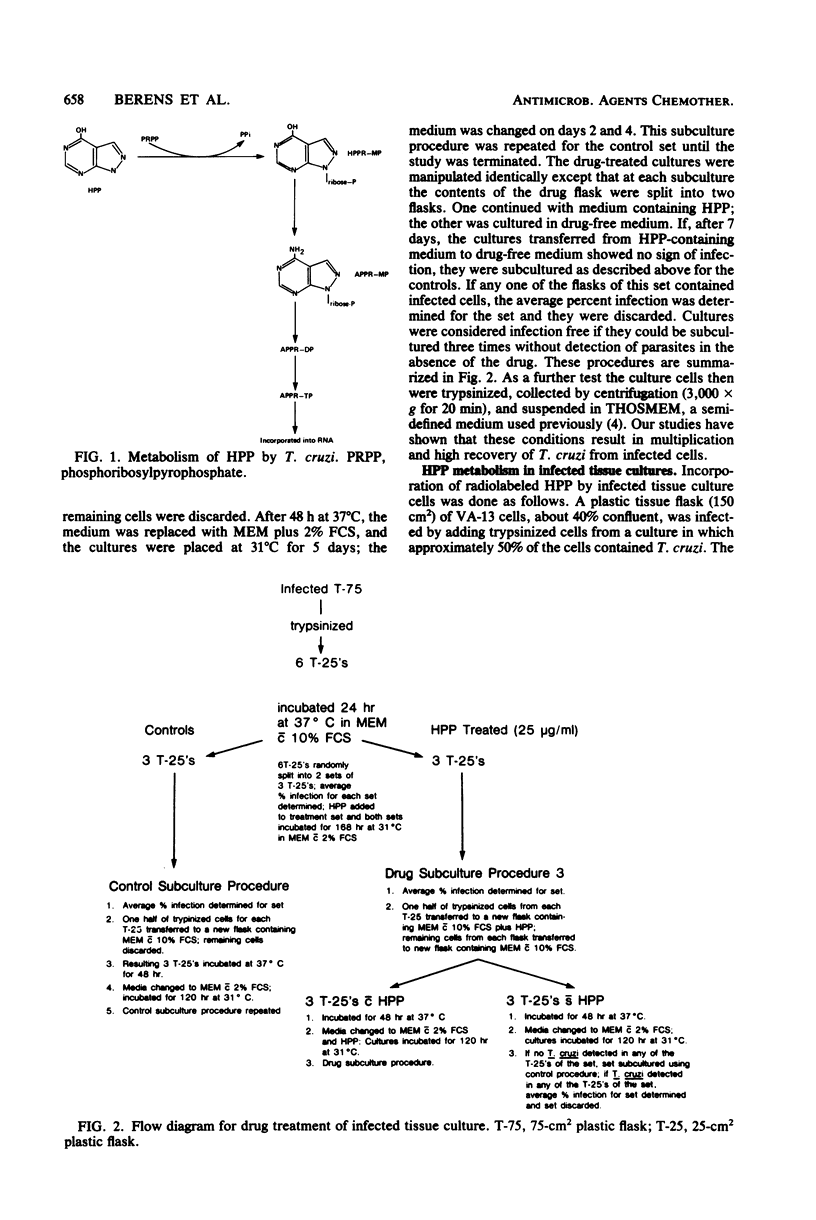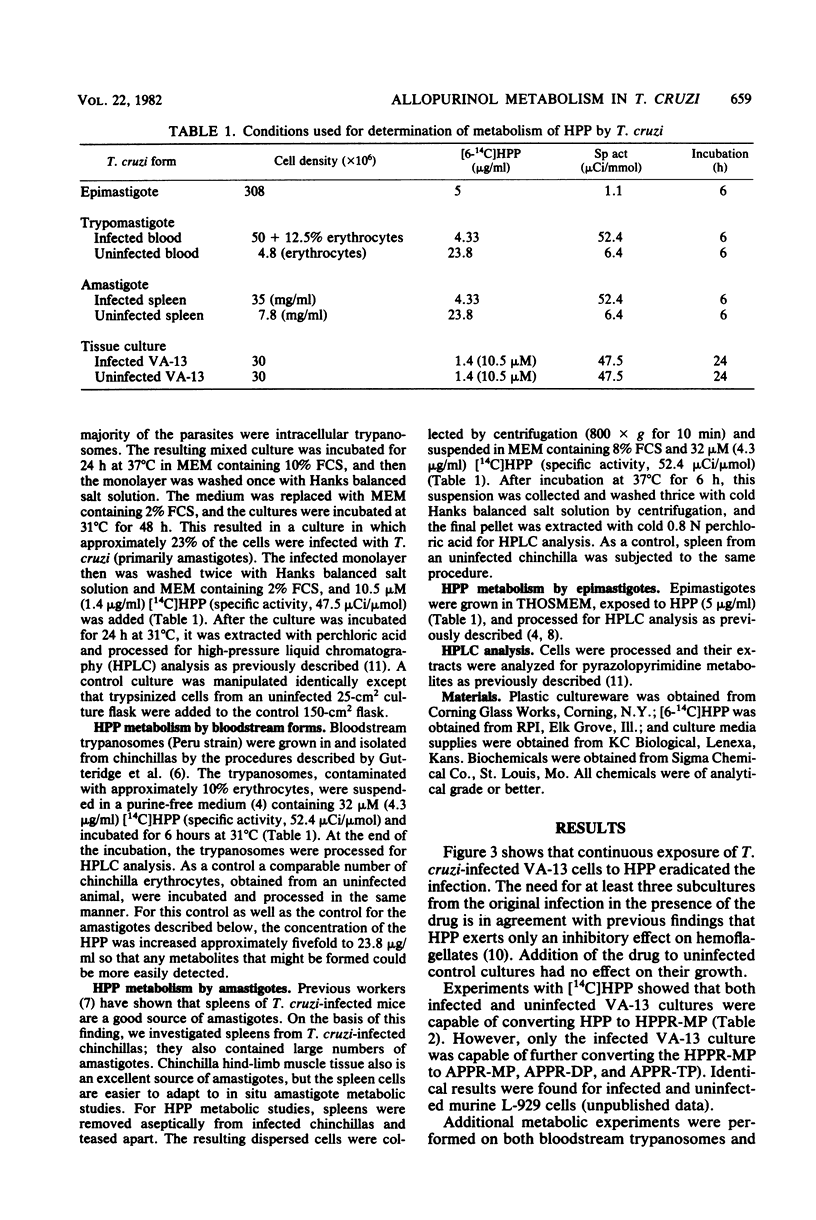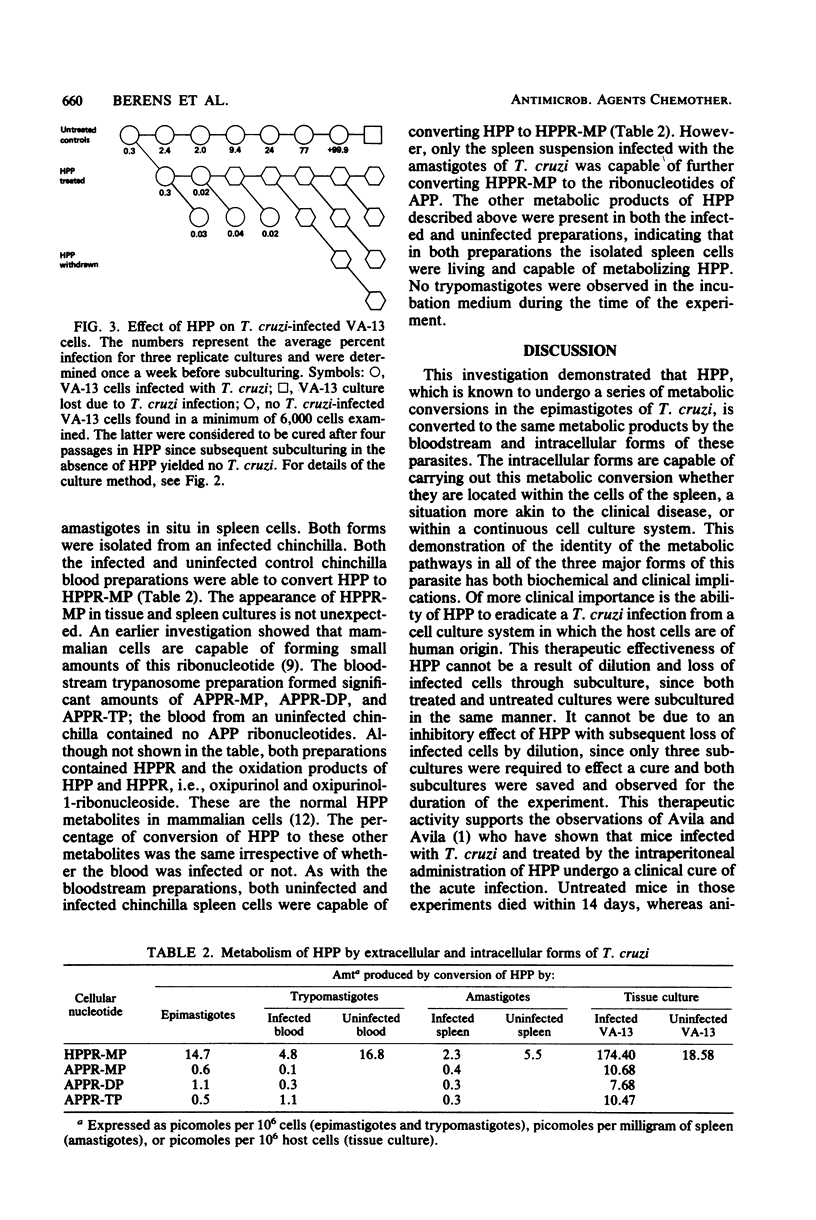Abstract
Allopurinol (4-hydroxypyrazolo [3,4-d]pyrimidine) is an effective agent in vitro against Trypanosoma cruzi. The important forms of this parasite, with respect to the pathogenesis of Chagas' disease in man, are the bloodstream (trypomastigote) and the intracellular forms. Experiments with radiolabeled allopurinol and analysis of the metabolic products of this compound by high-performance liquid chromatography showed that both the bloodstream and the intracellular forms of T. cruzi metabolize allopurinol in the same manner as has been shown for the epimastigotes in vitro. The metabolic pathways for pyrazolopyrimidines in the pathogenic forms were demonstrated with organisms isolated from infected animals and a tissue culture system infected with T. cruzi. Treatment of infected tissue culture with allopurinol eradicated the infection. This investigation implies that allopurinol may be useful in chemotherapy of T. cruzi infections, a supposition which has been borne out in one animal study.
Full text
PDF




Selected References
These references are in PubMed. This may not be the complete list of references from this article.
- Avila J. L., Avila A., Muñoz E. Effect of allopurinol on different strains of Trypanosoma cruzi. Am J Trop Med Hyg. 1981 Jul;30(4):769–774. doi: 10.4269/ajtmh.1981.30.769. [DOI] [PubMed] [Google Scholar]
- Avila J. L., Avila A. Trypanosoma cruzi: allopurinol in the treatment of mice with experimental acute Chagas disease. Exp Parasitol. 1981 Apr;51(2):204–208. doi: 10.1016/0014-4894(81)90109-0. [DOI] [PubMed] [Google Scholar]
- Berens R. L., Marr J. J., Brun R. Pyrazolopyrimidine metabolism in African trypanosomes: metabolic similarities to Trypanosoma cruzi and Leishmania spp. Mol Biochem Parasitol. 1980 Apr;1(2):69–73. doi: 10.1016/0166-6851(80)90001-8. [DOI] [PubMed] [Google Scholar]
- Berens R. L., Marr J. J., LaFon S. W., Nelson D. J. Purine metabolism in Trypanosoma cruzi. Mol Biochem Parasitol. 1981 Jul;3(3):187–196. doi: 10.1016/0166-6851(81)90049-9. [DOI] [PubMed] [Google Scholar]
- Berens R. L., Marr J. J., Nelson D. J., LaFon S. W. Antileishmanial effect of allopurinol and allopurinol ribonucleoside on intracellular forms of Leishmania donovani. Biochem Pharmacol. 1980 Sep 1;29(17):2397–2398. doi: 10.1016/0006-2952(80)90275-0. [DOI] [PubMed] [Google Scholar]
- Friess S. L., Hudak W. V., Durant R. C., Martin H. L. Comparative blocking actions of methylated 3-quinuclidinyl and 3-tropinyl residues in cholinergic systems. Biochem Pharmacol. 1973 Sep 1;22(17):2203–2204. doi: 10.1016/0006-2952(73)90121-4. [DOI] [PubMed] [Google Scholar]
- Gutteridge W. E., Cover B., Gaborak M. Isolation of blood and intracellular forms of Trypansoma cruzi from rats and other rodents and preliminary studies of their metabolism. Parasitology. 1978 Apr;76(2):159–176. doi: 10.1017/s0031182000047740. [DOI] [PubMed] [Google Scholar]
- Gutteridge W. E., Davies M. J. Enzymes of purine salvage in Trypanosoma cruzi. FEBS Lett. 1981 May 18;127(2):211–214. doi: 10.1016/0014-5793(81)80207-4. [DOI] [PubMed] [Google Scholar]
- Leon W., Villalta F., Queiroz T., Szarfman A. Antibody-induced capping of the intracellular stage of Trypanosoma cruzi. Infect Immun. 1979 Dec;26(3):1218–1220. doi: 10.1128/iai.26.3.1218-1220.1979. [DOI] [PMC free article] [PubMed] [Google Scholar]
- Marr J. J., Berens R. L., Nelson D. J. Antitrypanosomal effect of allopurinol: conversion in vivo to aminopyrazolopyrimidine nucleotides by Trypanosoma curzi. Science. 1978 Sep 15;201(4360):1018–1020. doi: 10.1126/science.356267. [DOI] [PubMed] [Google Scholar]
- Nelson D. J., Bugge C. J., Elion G. B., Berens R. L., Marr J. J. Metabolism of pyrazolo(3,4-d)pyrimidines in Leishmania braziliensis and Leishmania donovani. Allopurinol, oxipurinol, and 4-aminopyrazolo(3,4-d)pyrimidine. J Biol Chem. 1979 May 25;254(10):3959–3964. [PubMed] [Google Scholar]
- Nelson D. J., LaFon S. W., Tuttle J. V., Miller W. H., Miller R. L., Krenitsky T. A., Elion G. B., Berens R. L., Marr J. J. Allopurinol ribonucleoside as an antileishmanial agent. Biological effects, metabolism, and enzymatic phosphorylation. J Biol Chem. 1979 Nov 25;254(22):11544–11549. [PubMed] [Google Scholar]
- Sanderson C. J., Thomas J. A., Twomey C. E. The growth of Trypanosoma cruzi in human diploid cells for the production of trypomastigotes. Parasitology. 1980 Feb;80(1):153–162. doi: 10.1017/s0031182000000615. [DOI] [PubMed] [Google Scholar]
- Spector T., Berens R. L., Marr J. J. Adenylosuccinate synthetase and adenylosuccinate lyase from Trypanosoma cruzi, Specificity studies with potential chemotherapeutic agents. Biochem Pharmacol. 1982 Jan 15;31(2):225–229. doi: 10.1016/0006-2952(82)90215-5. [DOI] [PubMed] [Google Scholar]


